Is your pond not looking its best? Do you feel you’ve exhausted every treatment available to clear and restore its condition? If so, you’re not alone!
Whether you have a small or large pond, clearing ponds can be tricky, especially if you’re unsure what’s causing your pond water to appear murky, cloudy, or green.
Throughout this article, we uncover the 12 most common reasons why your pond water isn’t clearing, even after using one of our Envii pond products. Each point is followed by a simple solution explaining how to clear ponds suffering from that problem.
So, keep on reading to find out everything you need to know!
Jump to:
1. Water Volume 2. Overdosing 3. Pumps & Filters 4. pH 5. High Pond Nitrates
6. Well/Boar Hole 7. Pond Plants 8. Grass 9. UV Lights 10. Wrong Product 11. Patience
Videos:
How To Calculate the Volume of Your Pond • How to Clean Your Pond Filters • How to Check Your Pond Filters are Working
1. Pond Water Volume Dosage
Water volume is one of the most important things every pond owner should know about their pond. Not knowing their pond water volume is the most common reason people see little to no progress when attempting to make their water clearer.
Without calculating this measurement, it can be difficult to know if your pond is being treated correctly.
You can’t overuse our pond maintenance formulas, but pond owners will often underdose our products if they don’t know the volume of water in their pond. This means they aren’t treating it properly to see the best results.
So, how can you get the correct pond water volume measurement?
How do you measure a pond’s water volume?
To measure your pond, all you need is a measuring tape.
Measure the width, length, and depth of your pond (in metres) and multiply the measurements together. Then, multiply the answer by 1,000 – the final figure will be the volume of water in your pond (in litres). Alternatively, you can use our quick and easy pond water volume calculator.
Video: How To Calculate the Volume of Your Pond
2. Overdosing
We know what you’re thinking. We just claimed our products can’t be overdosed.
However, they can be overdone needlessly when they don’t need to be.
While it might seem like a good idea to add the whole contents of a product into your pond, it’s actually counterproductive.
Is too much beneficial bacteria bad for your pond?
Algae are a food source for beneficial bacteria. So, if your pond is filled with too many bacteria at any one time, they’ll simply fight and compete with each other until their numbers are low enough to focus on the food source.
This means pouring a full bottle of Pond Klear into your garden pond water is just wasting beneficial bacteria. This goes back to knowing your pond water volume so you can be sure of the correct amount of treatment to apply to your pond.

3. Pumps and Filters
Dirty or damaged pumps and filters are another reason your pond might not be clearing effectively. The job of a pump and filter is to assist the water system in cleaning the physical matter in your pond, such as debris, dead leaves, and organic matter and waste.
How often should you clean your pond filters and pump?
If you currently don’t clean your pond filter regularly, this can be a reason your pond treatments don’t seem to be working.
Without adequate cleaning, your filter system will be pumping dirty and murky water back into the pond. Therefore, the algae that causes green water and blanketweed have a continuous food source enabling them to thrive in your pond.
Depending on the condition of your pond, we recommend cleaning your filters every couple of days if they’re extremely dirty, and weekly if they’re moderately dirty.
Video: How to Clean Your Pond Filters
4. Pond Filter and Pump Quality
If you clean your pond filters regularly, they might not be working efficiently or be damaged and therefore can’t remove debris properly. Watch the video to the side for a simple hack to check if your pond filter is operating correctly.
If you’re relying on a submerged pond pump with a built-in filter, then you’re depending on a poor-quality mechanism that’s only as good as having a pond pump alone. In this case, our experts recommend installing a filter which has both mechanical and biological pond filter components.
Video: How to Check Your Pond Filters are Working
5. pH Levels
When your pond’s pH is imbalanced, being too high or too low, it will affect how bacteria perform at removing green algae from the water.
pH levels can flux for various reasons including rainwater runoff and the decomposition of organic material.
When the pH is too high (alkaline), it can slow the rate at which bacteria both consume algae and replicate – few bacteria reduce the volume of algae being consumed. An alkaline pond also allows algae to grow more vigorously, making it more difficult for bacteria to control and worsening the algae problem.
Likewise, acidic pH levels are just as harmful as these conditions kill off the beneficial bacteria that work to consume algae.
What pH should my pond be?
Much like how bacteria perform better in certain temperatures, they also require certain water parameters to work effectively. So, start by measuring your pond’s pH with a testing kit.
We recommend a pH between 7.5 to 8.5 – if your pond pH level is higher or lower than this, you should use a pond pH buffer, such as Pond Equaliser, to balance and neutralise the pH to the recommended reading before using a pond clearing treatment.
A pH between 7.5 to 8.5 also contributes to a healthy pond that’s safe for aquatic life – including your pond fish and plants – so should help everything living in your pond to thrive.
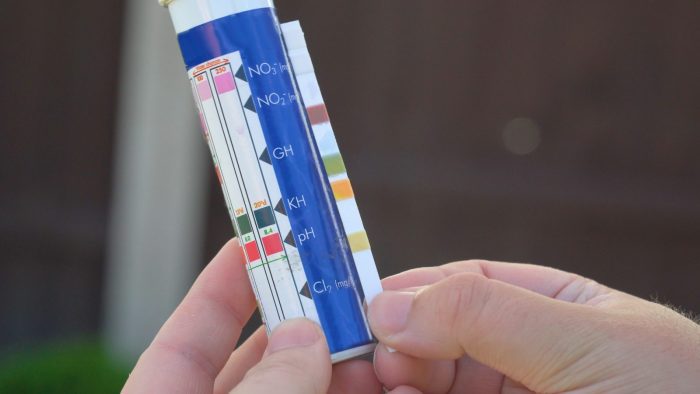
6. High Nitrate Levels
Pond algae thrive in water with high nitrogen levels.
High nitrate levels may occur if you’re overfeeding your fish. If your pond is newly established, or you’ve recently added too many fish, your water could be experiencing new pond syndrome – this is when spikes in nitrates and ammonia cause algae blooms and fish disease. Likewise, a lack of pond plants can lead to high nitrates as the plants will absorb the nitrates.
Nitrates produced from fish waste are the algae’s food source. If the nitrate levels are high and aren’t being reduced, the excess algae causing your pond to be dirty have an unlimited food supply and can grow faster and stronger than the bacteria that can suppress it.
How do I treat high nitrate levels that affect fish ponds?
Similar to measuring pH levels, you can test your pond’s nitrate levels with a testing kit. The recommended measure for nitrates should be between 20 and 60 ppm.
If you find that your pond’s nitrate levels are high, it will likely be the reason your green water isn’t clearing. Treat your pond with Nitrate Klear – this exceptional formula is full of beneficial bacteria that reduce the algae’s food source, and ultimately reduce algae levels in your pond.
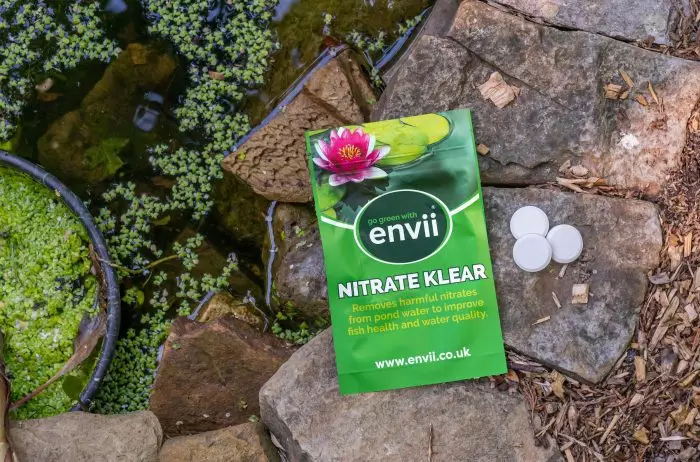
Related Products
-

Envii Nitrate Klear
£13.99Removes harmful nitrates from pond water.Add to Basket -
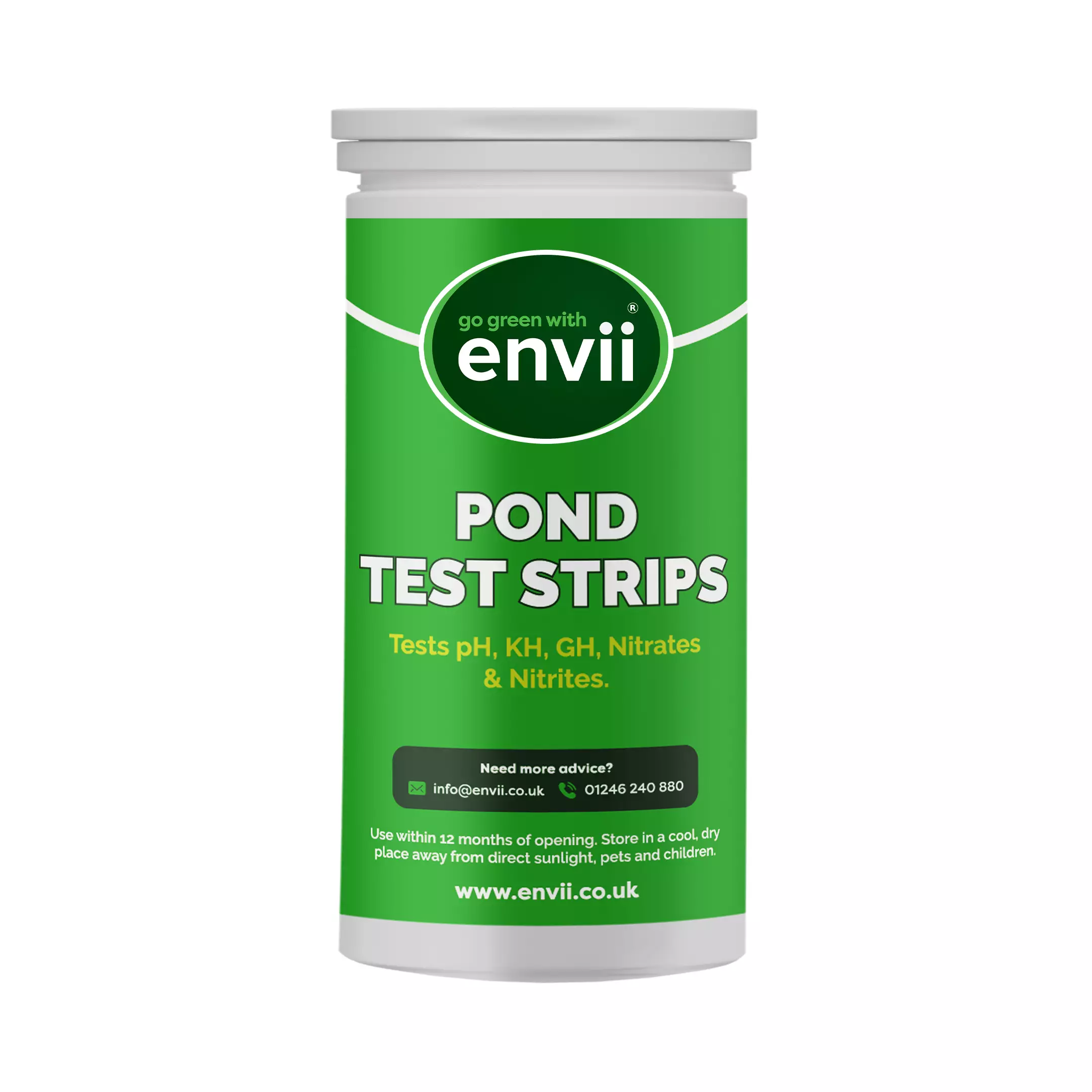
Envii Pond Test Strips
£11.99Easy to use Pond Test Strips measuring 5 key water parametersAdd to Basket
7. Topped-up pond water
A garden pond that has been re-filled with water from a tap, a well, or a borehole close to arable farming might also be a struggle to clear.
Firstly, tap water that hasn’t been treated can harm fish and even lead to fish death due to the chlorine present – so it must be treated regardless of whether your pond is clear or not. If your fish pass away as a result of chlorine intake and begin decomposing, this can create imbalanced pH levels and ultimately, a cloudy pond.
Secondly, water taken from a well or borehole to fill up your pond can prevent you from achieving a clear pond due to nitrates. This is because nitrogen from farm crop fertilisers leaches into the ground, contaminating the watercourse and then your pond.
Again, to eliminate this problem, you first need to treat your pond with Nitrate Klear so your pond pH and water parameters are balanced before starting with our beneficial bacterial treatments.
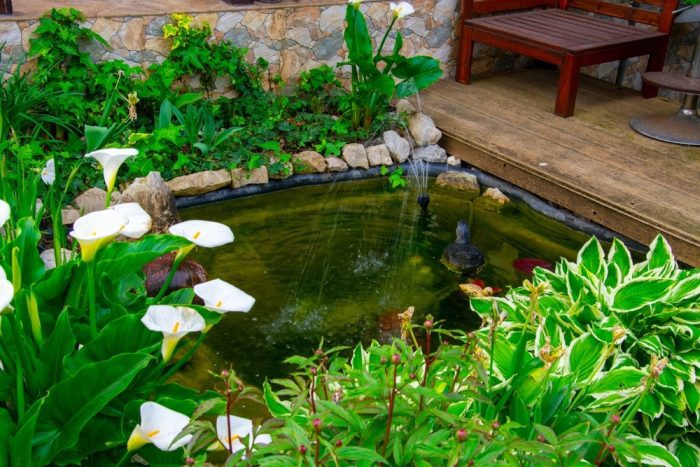
8. Recently Added Pond Plants
Nitrogen can also be unintentionally introduced into pond water through newly added pond plants.
Plants bought from garden centres and plant nurseries are typically fed with nitrogen fertiliser to keep them healthy. However, this fertiliser isn’t healthy for your pond and may leach into your water causing an increase in nitrate levels.
Luckily there’s a simple and straightforward solution for this. There’s no need to get rid of your aquatic plants. Simply sit brand new plants in a bucket of tap water for one week before adding them to your fish pond. During this week, you should also change the water every other day to fully leach out the nitrogen. This allows all the nitrogen-rich fertiliser to leak out of the plant so you can safely add them to your pond.

9. Grass
You might be treating your pond correctly, have working filters and your pond chemistry is balanced, but your water is still green. So what’s the reason your pond isn’t clearing?
Well, another plant that can affect the clarity of your pond water is grass.
In some cases, if cut grass falls into a pond, it can actually stain the water. Although this depends on the pond size and the amount of grass, it does happen.
If you realise this might be the problem, you need to do 20-30% water changes for a couple of weeks to get rid of the natural green dye.
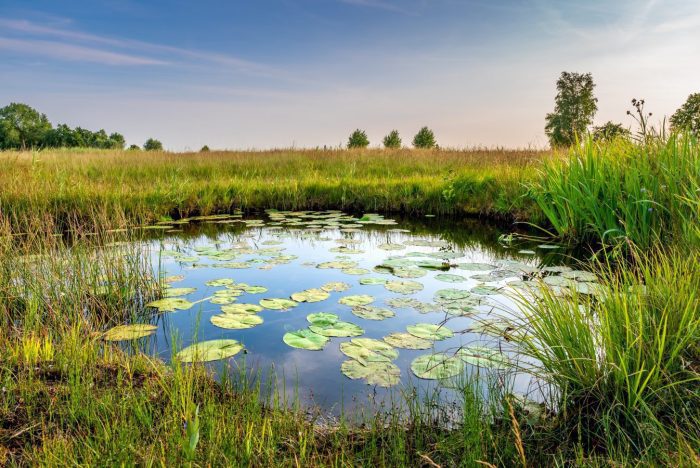
10. UV Lights On
One question we frequently get asked by customers is whether it’s okay to leave their ultraviolet clarifier/UV filters switched on in the pond while using our treatments.
UV filters or ‘clarifiers’ expose high levels of ultraviolet light to single-celled algae, working to destroy their DNA and kill them. However, this same ultraviolet light also kills off beneficial bacteria in the pond which are essential to prevent the build-up of organic waste and algae.
Many customers have used our products to clean a pond without UV filters, which suggests that beneficial bacteria are arguably better at keeping clear pond water. Some customers have even said they never bothered turning the UV lights back on!
Our pond cleaner products contain strains of bacteria with a UV ray tolerance. However, if you use UV filters in your pond, we advise that you turn them off for at least 48 hours after applying our beneficial bacterial products. This allows time for the bacteria to anchor themselves within the pond and multiply in sufficient numbers to suppress algae growth.
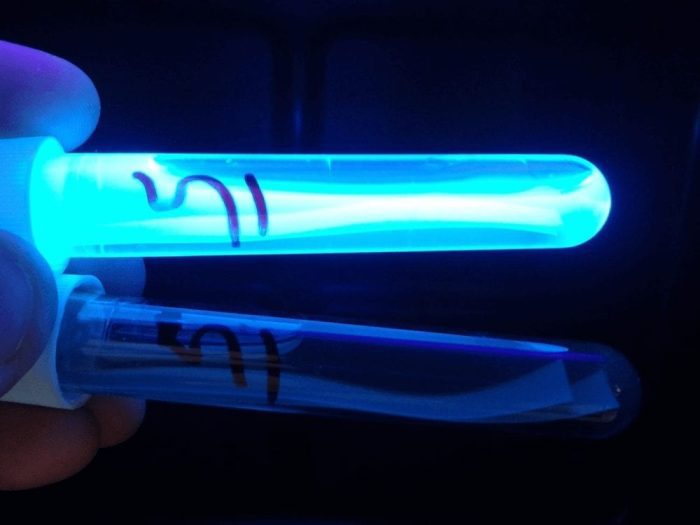
11. You’re Using the Wrong Product
Sometimes the answer to why your pond isn’t getting clearer is that you’re using the wrong product to tackle the cause of your cloudy pond. For example, many people often mistake submerged algae for blanket weed or green water for submerged algae and so on.
Our best advice is to make sure you correctly identify what your pond problem is before you commit to buying a treatment.
You can read any of our pond blogs for more tips on how to differentiate between each algae and the other causes of poor water quality and clarity.

Patience
Sometimes if your pond isn’t clearing after treatments, it’s just a case of patience. How fast your pond will see results depends on a range of things. Including the points mentioned in this post. However, the most important things to consider are the size and condition of your pond.
How long does it take for a pond to clear?
With continued regular treatments, your pond can see results from as early as 2 weeks. Again, with emphasis on the severity or condition of your pond. Typically, though, most ponds can expect to see results between 6 to 8 weeks. If this seems like a long time, remember that you’re using a natural, biological product, not chemicals. So, results will take some time, especially for really bad ponds.
If you have been using a product regularly for longer than this period of time and none of the points we have mentioned apply to your pond, give us a call for tailored advice and technical support.
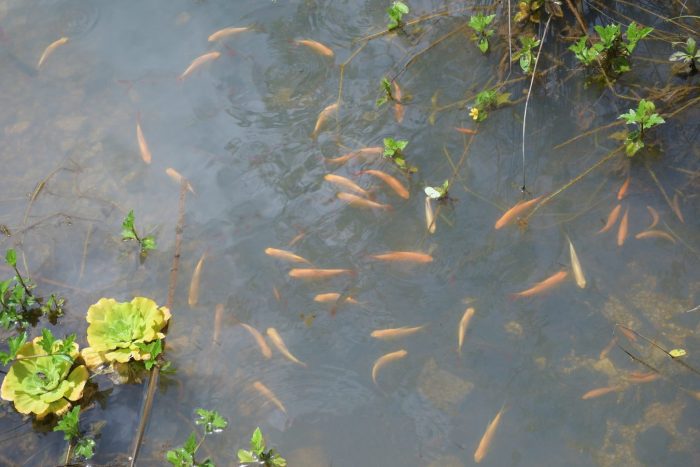
Speak to an expert for more advice
Knowing how to clear ponds with the best-suited treatment is easy once you discover what is causing your water to become murky or swamped. Plus, with our products recognised as organic, you can rest easy knowing treatments won’t harm wildlife or your pond life.
So, regardless of whether you’re looking for a treatment to clear green water or eradicate blanket weed, our specially formulated products help to remove algae and keep your pond clean and clear all year round!
If you’d like to speak with our knowledgeable team about your pond needs, feel free to get in touch on 01246 240 880.


 Call us on 01246 240880
Call us on 01246 240880 Free 48hr Delivery
Free 48hr Delivery Sign-up and receive 10% off
Sign-up and receive 10% off
Hi I recently brought lake clear 200sm off of Amazon on the 26th of May and put it into our pond.
We moved to a house last year which has a 68 foot long by 38 foot wide at the longest points it shelves but I’m not sure of where and how as I can’t see through the water it’s very green it’s 4 foot deep at highest point but it’s a foot down from the top right now. It o my has a pond pump it has no filter. I have planted 8 lilies and a mass of other plants to try and help clear the water.
I’d say it’s marginally clearer after using your product.
I’m just wondering if you could suggest what I can do next to try and clear the green water more.
There are many fish in the po d who all
Seem very healthy.
Many thanks Cassie